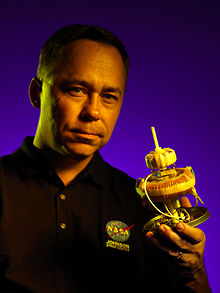哈罗德·G·怀特
| 哈罗德·怀特 Harold White | |
|---|---|
 | |
| 出生 | Harold Sonny White 1965年10月8日 |
| 国籍 | |
| 母校 | 南阿拉巴马大学(BS) 卫奇塔州立大学(MS) 莱斯大学(PhD) |
哈罗德·G·“桑尼”·怀特(英语:Harold G. "Sonny" White,1965年10月8日—)是一名美国机械工程师、航空航天工程师和应用物理学家,因提出新的阿库别瑞引擎概念和推动先进的推进系统项目而知名。
教育
[编辑]怀特获得南阿拉巴马大学机械工程学士学位,1999年获得卫奇塔州立大学机械工程硕士学位[1],2008年获得莱斯大学物理学博士学位[2][3]。
阿库别瑞引擎
[编辑]怀特开始在太空大会上展示自己的想法,并发表关于阿库别瑞引擎概念的提案,从而引起媒体的关注。2011年,他发表了一篇题为《曲速场力学101》(Warp Field Mechanics 101)的论文,概述了米给尔·阿库别瑞的超光速推进系统概念的更新理念,包括证明专案可行性的方法。阿库别瑞的概念曾被认为是不可行的,因为它所需的能量远远超过任何可行能源所能产生的能量。怀特重新计算了阿库别瑞的概念,并提出如果太空船周围的曲速气泡形状像一个环面,就会更加节能,使这个概念变得可行。怀特表示“曲速旅行”还没有进行过“芝加哥1号堆”实验,这指的是第一个核子反应堆,是为核能铺平道路的突破性演示[4][5][6]
为了研究曲速引擎的可行性,怀特和他的团队设计了一个曲速场干涉仪试验台来展示曲速场现象[5]。实验在美国国家航空暨太空总署林登·詹森太空中心的先进推进物理实验室("Eagleworks")进行。怀特和他的团队声称,这种改进的迈克生干涉仪可以探测到时空的扭曲,即曲场效应[7]。
2021年5月,怀特和他的团队宣布他们可能已经找到了测试“芯片级”阿库别瑞引擎所需的正确配置[8][9][10][11]。
电磁推进器
[编辑]2015年4月,太空爱好者网站NASASpaceFlight.com根据NASA Eagleworks工程师保罗·马奇(Paul March)在其网站论坛上发表的一篇帖子宣布,美国国家航空暨太空总署已成功在硬真空中测试他们的电磁推进器——这将是任何组织首次宣称此类测试成功[12]。2016年11月,怀特与NASA Eagleworks计划的其他同事一起发表了他们对拟议中的电磁推进器的研究结果[13]。事实证明,这种装置的建议工作原理不符合已知的物理定律,包括动量守恒和能量守恒。目前还没有为这种推进器提出任何可信的运行理论[14][15][16][17][18][19]
2021年3月,德累斯顿工业大学的物理学家发表了三篇论文,声称所有显示推力的结果都是假阳性,是由外力造成的[20]。
其他工作
[编辑]怀特和他的团队也正在研究其他几个“突破性空间技术”项目,其中包括一个新的推进器概念,怀特称这个概念是利用量子力学预测的效应来工作的。为了支持这项研究,怀特的团队也正在开发一种“微型天平”,它能够测量这种推进器预计产生的极其微小的力。为了校准这个天平,研究团队计划重复2006年不成功的伍德沃德效应实验,这次将使用新的微型天平[21]。
荣誉
[编辑]2006 年,怀特被美国国家航空暨太空总署署长授予NASA杰出成就奖,以表彰他在航天飞机返航期间为隔热系统机器人检查工具的制造、交付和认证所发挥的作用[3]。怀特也因“在执行STS-121航天飞机任务前发现并处理机械手臂的严重损坏”而获得美国国家航空暨太空总署机组办公室颁发的银史努比奖[3]。
参考资料
[编辑]- ^ Personnel page 互联网档案馆的存档,存档日期2017-04-26. - website of the Department of Mechanical Engineering of Wichita State University
- ^ Graduate Study Recent Theses 互联网档案馆的存档,存档日期2013-09-21. - website of the Physics and Astronomy Department of Rice University
- ^ 3.0 3.1 3.2 Icarus Interstellar. "Dr. Harold 'Sonny' White" 互联网档案馆的存档,存档日期2015-06-01., Project Icarus.
- ^ Oswald, Ed. "NASA working on faster-than-light space travel, says warp drives are 'plausible'" (页面存档备份,存于互联网档案馆), ExtremeTech.
- ^ 5.0 5.1 White, Harold. "Warp Field Mechanics 101" (页面存档备份,存于互联网档案馆), NASA, Houston, TX.
- ^ A Discussion of Space-Time Metric Engineering (页面存档备份,存于互联网档案馆) – Digital Library for Physics and Astronomy of Harvard University
- ^ Dvorsky, George. "How NASA might build its very first warp drive" (页面存档备份,存于互联网档案馆), io9.
- ^ Williams, Matt. The Dream of Faster-than-Light (FTL) Travel: Dr. Harold “Sonny” White and Limitless Space. Universe Today. 27 May 2022 [14 March 2023]. (原始内容存档于2023-09-21).
… in the process of looking at how the vacuum responds to these shapes, he and his team noticed something completely unexpected: ‘The custom Casimir cavities consist of two plates, and in between the two plates, we have pillars. When we were looking at how the models we have predicted how the quantum vacuum responds to those pillar-plate geometries – when we looked at a two-dimensional section cut of the vacuum energy distribution, it looked like a two-dimensional section cut of the energy density distribution needed for the Alcubierre Warp Metric.’
- ^ Ankers-Range, Adele. Scientists Take a Step Towards Building a Real-Life Warp Drive... By Accident. IGN. 31 December 2021 [14 March 2023]. (原始内容存档于2023-03-28).
- ^ Coontz, Lauren. DARPA and NASA Scientists Accidentally Create Warp Bubble for Interstellar Travel. Coffee or Die Magazine. Black Rifle Coffee Company. 9 December 2021 [14 March 2023]. (原始内容存档于2023-11-14).
- ^ White, Harold; Vera, Jerry; Han, Arum; Bruccoleri, Alexander R.; MacArthur, Jonathan. Worldline numerics applied to custom Casimir geometry generates unanticipated intersection with Alcubierre warp metric. European Physical Journal C. 17 May 2021, 81 (7): 677–686 [14 March 2023]. doi:10.1140/epjc/s10052-021-09484-z
 . (原始内容存档于2023-11-25).
. (原始内容存档于2023-11-25). The qualitative correlation would suggest that a chip-scale experiment might be explored to attempt to measure a tiny signature illustrative of the presence of the conjectured phenomenon
- ^ http://www.nasaspaceflight.com/2015/04/evaluating-nasas-futuristic-em-drive/ (页面存档备份,存于互联网档案馆) Evaluating NASA’s Futuristic EM Drive
- ^ White, Harold; March, Paul; Lawrence, James; Vera, Jerry; Sylvester, Andre; Brady, David; Bailey, Paul. Measurement of Impulsive Thrust from a Closed Radio-Frequency Cavity in Vacuum. Journal of Propulsion and Power. 2017, 33 (4): 830–841. S2CID 126303009. doi:10.2514/1.B36120. hdl:2060/20170000277
 .
.
- ^ The Impossible Propulsion Drive Is Heading to Space. popularmechanics.com. 2 September 2016 [9 October 2017]. (原始内容存档于2023-11-11).
- ^ Crew, Bec. The 'Impossible' EM Drive Is About to Be Tested in Space. sciencealert.com. [9 October 2017]. (原始内容存档于2023-12-16).
- ^ NASA Team Claims 'Impossible' Space Engine Works—Get the Facts. National Geographic. 21 November 2016 [9 October 2017]. (原始内容存档于2016-11-22).
- ^ Seeker. How The 'Impossible Drive' Could Break Newton's Third Law. 19 November 2016 [9 October 2017]. (原始内容存档于2023-11-11) –通过YouTube.
- ^ Ratner, Paul. EM Drive, the Impossible Rocket Engine, May Be Closer to Reality. bigthink.com. 2016-09-07 [2023-10-16]. (原始内容存档于2021-07-29).
- ^ Poitras, Colin. To Mars in 70 days: Expert discusses NASA's study of paradoxical EM propulsion drive. Phys.org. 7 December 2016 [1 May 2018]. (原始内容存档于2023-11-11).
- ^ Delbert, Caroline. Scientists Just Killed the EmDrive. popularmechanics.com. Popular Mechanics. 31 March 2021 [29 June 2021]. (原始内容存档于2021-04-21).
- ^ Eagleworks Laboratories: Advanced Propulsion Physics Research (PDF). NASA. 2 December 2011 [10 January 2013]. (原始内容存档 (PDF)于2023-11-11).
